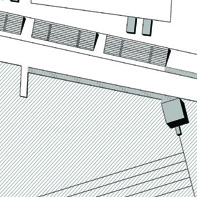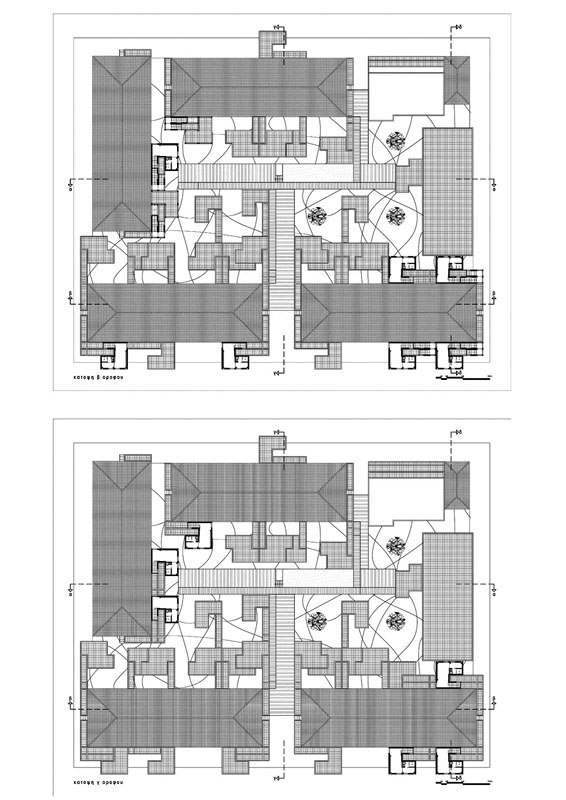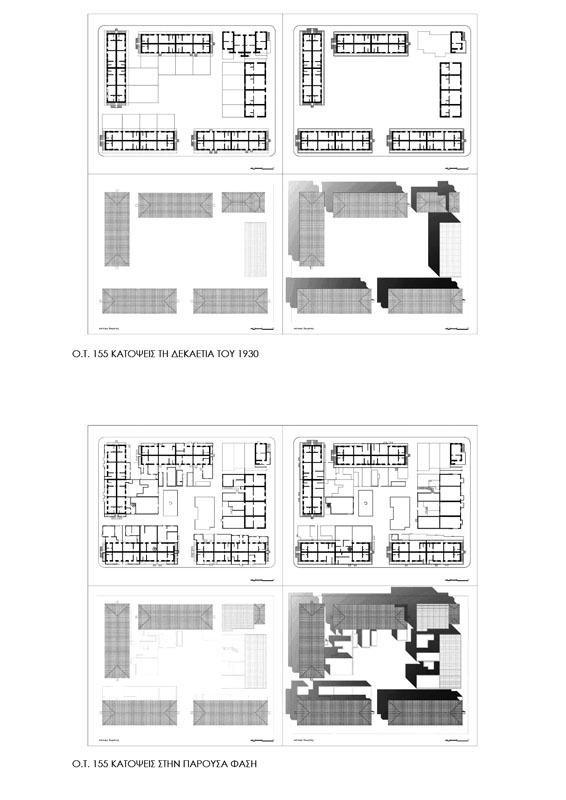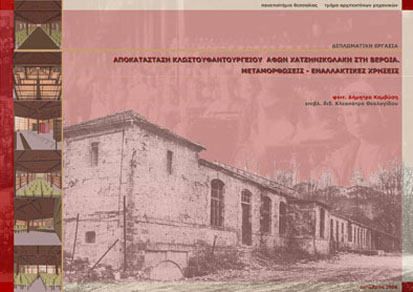.jpg)
.jpg)
The graduate work refers to the breakwater of the port of Volos. The personal analysis concluded in a new model of habitation. With the intention of elongating the city’s space usages onto the sea, residence, trade, culture, office, education, square issued from the city and came to bind to the arm of the breakwater. They anchored there. Volumes were created according to geometric consequence, adjusted to the scale of the receiving surface, and placed so as the facade they form has reference to the existing urban façade.
The usages are being developed in two levels and the arm breaks in certain points so as to favor boats’ passing through. It is linked with the city not only by land, but also by the sea, since new boat service is being established. On the first part there is a space for university lectures, a square, a café, a book exhibition, offices of the sailing club, a market, a booking office , and also platforms for walkers or fishermen. On the second part there are students’ houses.
Having as a primary goal the constant movement, and the plot of transforming incidents, the usages that have been chosen, do that exactly. People come and go at the cafe, the market sales each day different products, students leave from their homes after graduation, and be replaced by others.
Supervisor: Trova Vasso
Reference Number: 85


The current study focuses on the reformation of rowing facilities in Ioannina nautical club. The area of the project, which is under study, locates in the lake coast of the city of Ioannina. This area includes facilities, rowing facilities in particular, which are organized sectionally in the specific area site and they are discernibly segregated into four zones.
The target of this project study, as far as the segregation previously mentioned is concerned, is to reform the rowing facilities as well as the lake coast, in which they are located, in such a way so that they are placed among a unified functional system.
Supervisor: Trova Vasso
Reference Number: 89












This project focuses on the housing block 155 (H.B. 155) in Nikea, a municipality founded on the outskirts of Athens, following the dramatic events of population exchange of 1922 (the so-called “Asia Minor Catastrophe”). Block’s width is 50 meters and height is 70 meters. Two side streets perpendicular between them cross the block. The centre of block is a public open-air space. The characteristic features of the block are the arbitrary and off-hand additions-extensions of the original building cells made by the owners.
Project’s purpose is to preserve the original building cells, to remove the arbitrary extensions and to build new ones in a way that keeps the “block’s entropy”. “[entropy]…this is therefore not about “inventing” new forms, new strategies, new programs or new sites as such. It is about reinventing them again and again, by submitting them to a process of continuous sampling, splicing, mixing…” (INDEX ARCHITECTURE, The MIT Press, Cambridge, Massachusetts 2003)
I searched for the basic forms of extensions in the specific block structure, trying to trace their typology. The dwelling’s evolution is strictly connected to the number of inhabitants that form the household. I chose to maintain the pattern that these extensions follow. That is, an arraying of small structures without a fundamental concept concerning the final form. My approach is the parallel or perpendicular apposition to the original building cells. This apposition is not about the level of the original cells but concerns the space as a whole. So, each dwelling can be developed in other levels too, besides the ones that belong to the original cells. That leads to the expansive habitation of each dwelling in space (e.g. Ground floor-1st floor-ground floor etc. or 1st floor-ground floor-1st floor etc.). The image of the H.B. 155 which is presented in this project is the result of the inhabitants/square meters ratio of each dwelling. The architectural designs of this project include:
- Sixty two residences, hosting one to seven inhabitants each.
- Seven abandoned properties that are changed into small stores for the purpose of serving the inhabitants of the housing block.
- The landscape at the public open-air space in the inner block includes: wooden decks-connecting the original cells-, garden area and a playground. These spaces are set in different levels, between (-0.85m) and (+0.45m). At one of these levels, an ephemeral open- air cinema, with a capacity of seventy (70) seats, will be assembled.
Supervisor: Papadopoulos Spiros
Reference Number: 60










The aim of the diploma project is the reformation of the waterfront of the city of Volos. This part expands from the waterborne platforms, which are opposite the city hall and close to the port, up to Papastratos building.
The realization of the concept began with the tracing of the space. The tracing had been made by the reduction of specific spatial qualities based on the different apprehension of space between a pedestrian and a cyclist. The minimum time the cyclist needs to cover a distance and the continual rotation of the visual field, creates a fragmentary and subtractive space in which the scale of the objects consisting it changes dramatically.
During the mapping of this experience, we came up with representations of space based on rough models, sketches, photo- collages and optical texts. Together with this action, a fundamental vocabulary based on “wedge” had been elaborated. This vocabulary supports the organization and combination of the forms that arise from the mapping.
These representations create new spatial qualities, which are placed between the environment and the reconstruction of it. Thus a new composition is being made based on the “wedge vocabulary”. These qualities consist the medium that determinates the final forms of the project.
The project suggests the redesigning of the surface, lighting and seat infrastructure moreover it involves the designing of public squares, which occasionally will be used for the annual book festival.
With this proposal, the waterfront of Volos has the chance to gain a unique touch and a chance to serve in the best way its public and activities.
Supervisors: Gavrilou Evelyn, Kalara Nandia
Reference Number: 88


Athens is the only European capital that does not have a building of lyric theatre. The Greek National Opera is accommodated the last 50 years in the theatre "Olympia" that despite the efforts for renovation from time to time the theatre is unsuitable.
The building site that is proposed for the construction of a New National Lyric building with datum the fact that the G.N.O. from the first day of foundation is found in the centre of Athens and the very big in scale building program that is required for the accommodation of such building, is the space of the stadium of Panathinaikos F.C. in the Alexandra’s Avenue. The prospect of reformation of the particular region and the relocation of the stadium in new site plays decisive role in the choice of this building site.
The conductor plays a very important role before and during the play. It could be said that the role of the conductor resembles a lot with the role of an architect. He is analyzing the needs of the play - building, it assembles the essential individual elements, he senses the play - processes it, and finally he is the one that with his gestures materialises it. Consequently the movement that the conductor is making can be translated into architecture. Thus the composition of the building results from the combined movements of the conductor that organises the ground plan and then the elevation.
Supervisor: Kotionis Zissis
Reference Number: 62
The study concerns the restoration and the reformation of the Hebrew town-section of Barbouta in Veria, a unique model of closed triangular parish in Europe, aiming at its upgrade and presence in everyday life of the city.
Historical and urban elements of the city and the particular parish are recorded in the study, followed by the enlistment of all buildings in Barbouta, according to architecture, current condition, previous interventions and uses, initial and current. This information is documented in cards, for each building, and then is placed in regional plans, at a scale of 1:200, so that we have a complete view of the area.
The study includes four groups of designs. The first one concerns the imprinting of the region in the beginning of 1980s. In this case the plans where redesigned. The second group includes imprintings for the current condition, the third one includes documentation of the current condition and the last group includes the proposal itself.
The proposal consists of two parts. The first part concerns the parish as a whole and includes suggestions for the utilisation of the buildings, and refinement of the shared spaces. The second part includes the study of the restoration and reuse of specified buildings and the design of new buildings in empty lots.
Supervisor: Theologidou Cleopatra
Reference Number: 82


The study examines the spinning mill in Veroia, which was built in 1906. The factory is situated in the area, called Muarif, next to the river “Tripotamos”, in an environment of special natural beauty. The factory consists of five buildings, of a total area of 1887.30m2 which lie on a ground of 24801.64m2. The factory used to be water-driven. Approximately 130 people worked in it. Its function stopped many years ago. The electric generator that was placed in the main building still stands there. Even though the factory is abandoned, it is preserved in a good condition. Today, the Ousoultzoglou family owns it. The aim of this project is to study the factory’s history, the circumstances under which it was built, its present situation, its restoration and its possible future incorporation in the town of Veroia, with its reuse with new uses.
The study consists of seven chapters.
The first chapter includes the historical documentation, starting from the town of Veroia, the founders of the factory, the conditions under which it began to work, the mechanical equipment, and the financial heading of the business. This study was based on relevant bibliography, as well as information from the diary of its owner, Stefanos Hatzinikolakis.
In the second chapter, the architectural survey and the plan of the factory are presented. The architectural survey was made with repeated tape measurements. The third chapter examines the structural phases of all buildings.
The fourth chapter presents the pathology of the buildings, which was examined on site, with detailed photographic documentation.
The fifth chapter deals with the restoration of the building’s husk, which aims to conserve all important elements and values that place it among the monuments of industrial heritage. In the sixth chapter, the new uses, the building’s plan and the necessary constructions for the new uses, are presented.
Finally, the seventh chapter includes the study of a new building at the place of an old one, as it came out from the historic documentation.
Supervisor: Theologidou Cleopatra
Reference Number: 111


The enchase was the wonder what is like for someone to have no answer to a question such as “address of residence?”. Beginning from there were located the problems that the homeless people in the cities, face in their everyday life.
In the city of Athens the number of homeless is believed to be approximately 17.000 persons. However, nobody cannot confirm this number, considering that, in Greece, an official count of homeless has never taken place.
Objective of this project is a proposal in the direction of the relief of daily needs of the homeless. The scenario concerns provision of services of information, permanent postal address, storage of personal objects, services of personal hygiene and cleanness, concentration of all social and medical services that go along with the homeless population. Provision of food will be offered in addition to the already existing infrastructures while accommodation will be provided in limited scale and only in exceptional cases, as a rest of their everyday routine and so as not to create a ghetto.
The concept is based on the hypothesis of creating something mainly for the homeless that do not have access in any kind of shelter. However, this does not rule out the rest of the homeless population.
The idea aims the creation of building that will manage to combine controversial qualities. An embrace that it will encompass, protect, it will withhold but also it will signal the homeless population. An architectural project where the outdoor space will have a decisive role, around which the main concept revolves.
The objective is to create a landmark for the homeless population, as well as for the entire city, which will, at the same, be time as introvert as its users. The building is organised in the site in fragments. It is deconstructed in order to be re-organised in a new total, active part of which will be also the outdoor space.
Supervisor: Kotionis Zissis
Reference Number: 63

